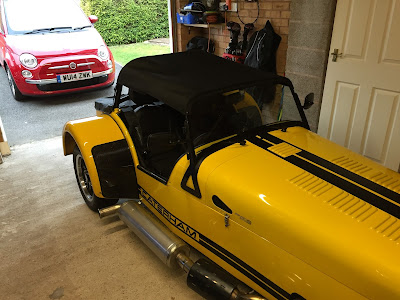I took it steady for the first 500mi or so and ramped it up from there. When I started to open it up, I found that the car offers such exhilarating performance it's rather difficult to drive it sensibly! Corners that used to be 'corners' in other cars the Caterham (now named Stiggy due to the plates) takes far faster than ever before without it really feeling like a corner. The acceleration is a whole new experience; my ST is quick, but this is a totally different experience. The immediacy (due to being NA and not turbo charged) is what stands out for me, there is instant throttle response. That response teamed with the wind in your face makes it all the more fun.
I must confess to buying him a few 'presents' in this first month:
- A half hood - very nice quality from Thundersport. Much, much easier to put on than the full hood and great for passing showers.
- A quick release steering wheel - I very quickly found that getting in and out was rather challenging! That, and the fact I didn't really want to leave the car anywhere but the garage fuelled this purchase. Not that installing the QR wheel was easy! Getting the old upper steering column out took some ingenuity (aka more strength than I possessed). Then getting the upper mounting bush back in the dash, I went too far and ended up with a bush wedged a fair way down the outer steering column. After sawing through the bush to remove a piece and crush it, I managed to pull it free. A replacement bush from Caterham worked a treat the second time. I would probably advise that these bushes are a one-use item (only £7.50ish); I think I damaged the locating features on removal and so it didn't locate when I tried to replace it.
- Velcro pads on the harnesses - these are dead useful in stopping the pull tabs from the harness whipping you in the face while driving!
- New mirrors - a smaller pair of mirrors that fit onto the windscreen stanchion, so they are available doors on or doors off. The size is much more in keeping with the proportions of a Seven and they don't vibrate as much either!
Sorry for the lack of any decent pictures, but here are a few from the Queen's Square Bristol Breakfast Club to make up for it! Who knew there were so many cool cars in Bristol! Including a P1!
 |
| Looking tiny next to a Focus RS |

















































